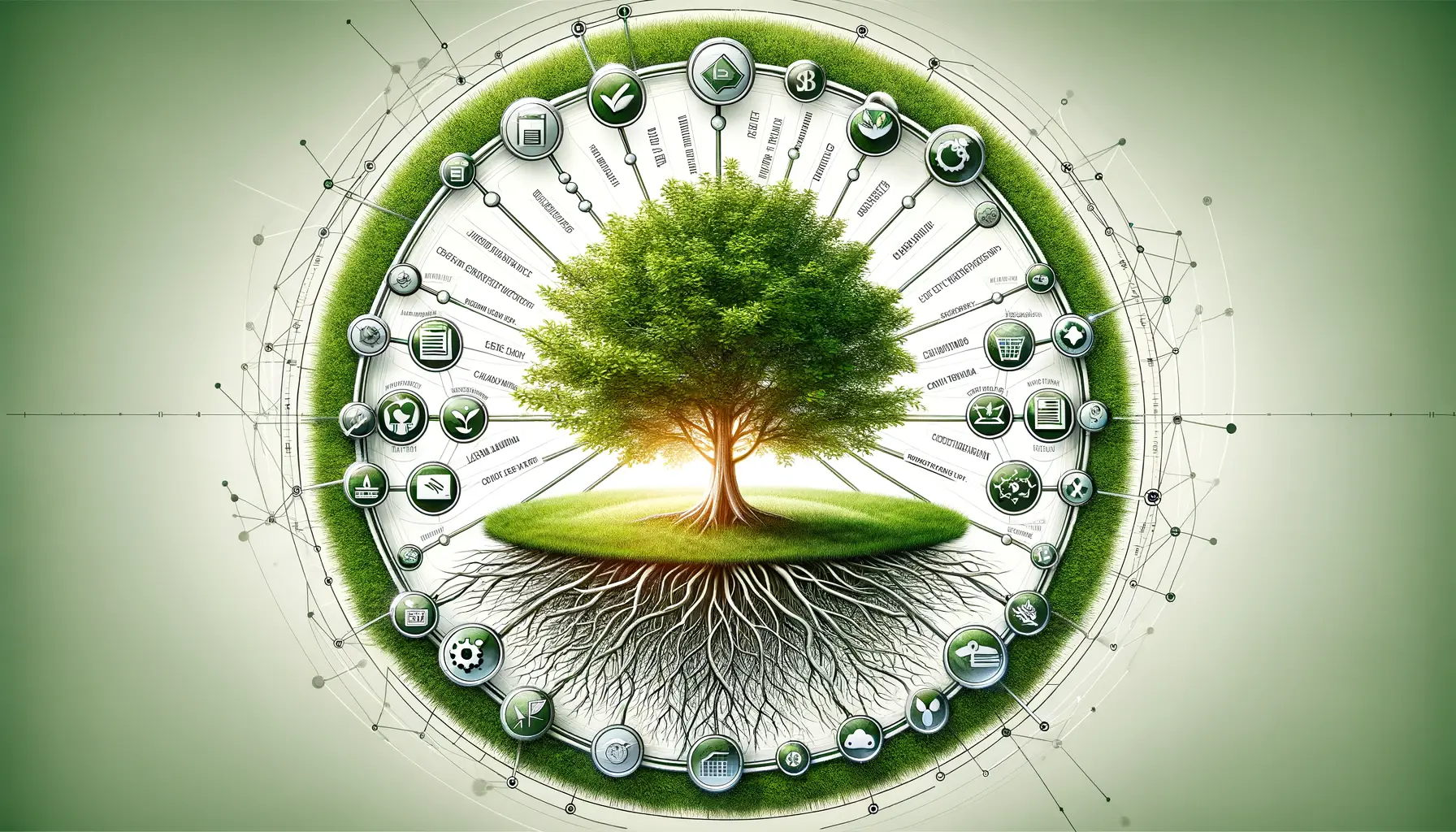In today’s digital age, where the internet has become the cornerstone of business operations, integrating sustainability into your brand’s web strategy is not just a trend but a necessity.
The concept of sustainability goes beyond mere environmental conservation; it encompasses a broader spectrum of practices aimed at promoting economic, social, and environmental health for the long term.
As consumers become increasingly aware of the impact their choices have on the planet, brands that prioritize sustainability in their online presence are not only contributing to a healthier world but are also positioning themselves favorably in the market.
The importance of weaving sustainability into your brand’s web strategy cannot be overstated.
In an era where information is readily accessible, consumers are leveraging the power of the internet to make informed decisions about the products they purchase and the companies they support.
A brand that showcases its commitment to sustainable practices online demonstrates transparency, accountability, and a genuine concern for global challenges.
This not only resonates with environmentally conscious consumers but also builds trust and loyalty, which are invaluable assets in the competitive digital landscape.
- The Foundation of Sustainable Web Strategy
- Strategies for Embedding Sustainability in Web Content
- Optimizing Website Design for Sustainability
- Engaging Your Audience with Interactive Sustainability Features
- Measuring and Communicating Impact
- Challenges and Solutions in Sustainable Web Strategy
- Future Trends in Sustainable Web Strategy
- Embracing Sustainability: A Strategic Imperative for Brands
- Key Takeaways for a Sustainable Future
- Sustainability in Your Brand’s Web Strategy FAQs
The Foundation of Sustainable Web Strategy
At the core of a sustainable web strategy lies the understanding that every digital action has a real-world impact.
From the energy consumed by servers hosting websites to the electronic waste generated by outdated technologies, the digital footprint of a brand can be significant.
Recognizing this impact is the first step towards minimizing it.
A sustainable web strategy involves making conscious choices in web design, hosting, content creation, and user experience to ensure that they align with the principles of sustainability.
Implementing a sustainable web strategy requires a multifaceted approach.
It begins with selecting green web hosting providers that use renewable energy sources to power their data centers.
This is complemented by optimizing website design for energy efficiency, such as reducing file sizes for faster loading times and lower energy consumption.
Additionally, creating content that promotes sustainable practices and incorporating eco-friendly themes into your brand’s online narrative can engage and educate your audience on the importance of sustainability.
Benefits of a Sustainable Web Presence
A sustainable web strategy offers numerous benefits, both for the environment and for the brand.
Environmentally, it contributes to the reduction of carbon emissions, conserves energy, and promotes the use of renewable resources.
For the brand, it enhances reputation, aligns with consumer values, and opens up new market opportunities.
Brands that are seen as leaders in sustainability can differentiate themselves from competitors, attract environmentally conscious consumers, and foster a loyal customer base committed to sustainable living.
Moreover, a sustainable web strategy can lead to operational efficiencies and cost savings.
By optimizing website performance and reducing resource consumption, brands can decrease hosting costs and improve site speed, enhancing the overall user experience.
This not only contributes to higher customer satisfaction but also positively impacts search engine rankings, making sustainability a smart choice for both the planet and business performance.
Incorporating sustainability into your brand’s web strategy is a powerful way to demonstrate your commitment to a better future, resonate with your audience, and achieve competitive advantage in the digital world.
Strategies for Embedding Sustainability in Web Content
Embedding sustainability into your brand’s web content is not just about stating your eco-friendly initiatives; it’s about creating a narrative that reflects your brand’s commitment to sustainability at every touchpoint.
Here are strategies to effectively integrate sustainability into your web content:
Highlighting Sustainable Practices and Policies
Start by openly sharing your brand’s sustainable practices and policies.
This transparency builds trust with your audience.
Detail your efforts in reducing carbon footprints, utilizing renewable energy, or supporting local communities.
Use real-life examples and stories to illustrate how these practices are implemented and the impact they have.
For instance, if your company has shifted to green packaging, describe the process, the materials used, and the difference it makes.
This not only informs but also educates your audience about the importance of such practices.
Creating Engaging and Educational Content
Develop content that educates your audience about sustainability.
This could be blog posts, infographics, or videos that explain complex environmental issues in simple terms, offer tips for a more sustainable lifestyle, or highlight the importance of supporting sustainable brands.
- Blog Posts: Write articles that delve into topics related to your industry’s impact on the environment and how your brand is working to mitigate these effects.
- Infographics: Use visually appealing infographics to convey statistics and facts about sustainability, making the information more digestible and shareable.
- Videos: Create video content that showcases your sustainable initiatives in action or features thought leaders discussing the importance of environmental responsibility.
Leveraging Social Proof
Include testimonials, case studies, and endorsements that speak to your brand’s sustainability efforts.
Hearing about positive experiences from other customers or respected figures in the sustainability community can significantly influence potential customers’ perceptions and decisions.
Case studies that detail a project or initiative’s journey, challenges faced, and the outcomes achieved can be particularly compelling.
They not only demonstrate your commitment to sustainability but also your brand’s problem-solving capabilities and dedication to making a real difference.
Remember, the goal is to weave sustainability so naturally into your web content that it becomes an unmistakable part of your brand identity, resonating with and attracting a like-minded audience.
Optimizing Website Design for Sustainability
Optimizing your website’s design for sustainability is a crucial aspect of your brand’s web strategy.
A well-designed, eco-friendly website not only minimizes its carbon footprint but also enhances user experience, leading to increased engagement and loyalty.
Here are key strategies to achieve an optimized, sustainable web design:
Efficient Use of Resources
Efficiency is at the heart of sustainable web design.
This involves optimizing images and videos to reduce file sizes without compromising quality, which decreases loading times and energy consumption.
Employing responsive design ensures your website is accessible and performs well across all devices, further reducing energy use by adapting content to fit different screen sizes seamlessly.
Additionally, consider the overall layout and structure of your website.
Simplifying navigation and removing unnecessary elements can make your website more user-friendly while also reducing the amount of data that needs to be loaded and processed.
Green Hosting Solutions
Choosing a green hosting provider is another critical step in optimizing your website for sustainability.
These providers use renewable energy sources, such as wind or solar power, to run their data centers.
They also often invest in carbon offsetting initiatives to balance out any emissions they cannot eliminate.
- Research: Look for hosting providers that have a strong commitment to environmental sustainability, with clear policies and practices in place.
- Energy Efficiency: Select providers that use energy-efficient servers and cooling systems to further reduce their environmental impact.
Minimizing Energy Consumption Through Design
The color scheme and elements used in your website’s design can also affect its energy consumption.
Darker colors generally require less energy to display on LED screens, contributing to lower energy use.
Incorporating this into your design philosophy can help reduce the overall energy consumption of your website.
Moreover, implementing a “dark mode” option for users can further enhance this effect, providing a more energy-efficient viewing option that also reduces eye strain in low-light conditions.
Sustainable web design is not just about reducing your website’s environmental impact; it’s also about creating an online space that reflects your brand’s commitment to sustainability and enhances the user experience.
Engaging Your Audience with Interactive Sustainability Features
Engaging your audience is crucial in promoting sustainability through your brand’s web strategy.
Interactive features not only captivate users but also educate them on sustainability practices, making your website a dynamic platform for environmental advocacy.
Here are innovative ways to engage your audience:
Interactive Sustainability Reports
Transform your sustainability reports from static PDFs to interactive web experiences.
Use animations, clickable charts, and scroll-triggered reveals to guide users through your sustainability journey.
This approach makes the information more accessible and engaging, encouraging users to explore your achievements and commitments in depth.
Interactive reports can also include features like calculators that show the impact of users’ actions, such as carbon footprint calculators, making the experience both educational and personal.
Virtual Tours and Experiences
Offer virtual tours of your facilities, highlighting sustainable practices and technologies in action.
This could be a 360-degree tour of a green manufacturing plant or an interactive map showing the origin of sustainable materials.
Such features provide a transparent look into your operations and reinforce your brand’s commitment to sustainability.
Virtual experiences can extend to product demonstrations, showing the lifecycle of a product from sustainable sourcing to eco-friendly packaging.
This not only educates but also builds trust in your brand’s sustainability claims.
Community Engagement Platforms
Create platforms on your website where your audience can participate in sustainability initiatives.
This could be a forum for sharing eco-friendly tips, a platform for crowd-sourcing ideas for sustainability, or a feature that allows users to contribute directly to environmental projects your brand supports.
Engaging your audience in this way fosters a sense of community and shared purpose.
It transforms passive consumers into active participants in your brand’s sustainability efforts, creating a deeper connection and loyalty to your brand.
By incorporating interactive sustainability features into your website, you not only enhance user engagement but also empower your audience to become advocates for sustainability, amplifying your brand’s impact on the environment.
Measuring and Communicating Impact
For brands committed to sustainability, accurately measuring and communicating the impact of their initiatives is essential.
This transparency not only reinforces trust but also demonstrates the brand’s genuine commitment to making a positive difference.
Here’s how to effectively measure and communicate your sustainability impact:
Establishing Clear Metrics
Begin by establishing clear, quantifiable metrics for measuring the impact of your sustainability efforts.
These could include reductions in carbon emissions, water saved through conservation efforts, or the amount of waste diverted from landfills.
By setting specific targets, you can track progress over time and make adjustments as needed to achieve your sustainability goals.
- Carbon Footprint: Calculate the total greenhouse gas emissions produced directly and indirectly by your brand.
- Resource Conservation: Measure the amount of natural resources (such as water and energy) your brand has saved through various conservation initiatives.
- Waste Reduction: Track the decrease in waste generated by your operations and the increase in materials recycled or repurposed.
Utilizing Digital Platforms for Transparency
Digital platforms offer an unparalleled opportunity to communicate your sustainability impact transparently.
Create a dedicated section on your website for sustainability reporting, where you can share updates, progress reports, and stories behind the numbers.
Use engaging visuals, interactive charts, and videos to make the data more accessible and engaging to your audience.
Additionally, leverage social media to share milestones and stories of impact.
This not only keeps your audience informed but also encourages shares and discussions, increasing awareness and support for your sustainability efforts.
Engaging Stakeholders in Your Sustainability Journey
Engaging stakeholders — including customers, employees, and partners — in your sustainability journey is crucial for amplifying impact.
Share stories of how collective efforts are making a difference, and invite feedback and ideas for further improvements.
This collaborative approach fosters a sense of community and shared purpose around your sustainability mission.
- Customer Engagement: Encourage customers to participate in sustainability initiatives, such as recycling programs or community clean-up events.
- Employee Involvement: Involve employees in sustainability planning and execution, recognizing their contributions and innovations.
- Partner Collaboration: Work with suppliers, distributors, and other partners to enhance sustainability throughout your supply chain.
Accurate measurement and transparent communication of your sustainability impact are not just about showcasing your brand’s achievements; they’re about inspiring action and driving collective progress towards a more sustainable future.
Challenges and Solutions in Sustainable Web Strategy
While the integration of sustainability into a brand’s web strategy presents numerous benefits, it also comes with its set of challenges.
Addressing these challenges head-on with innovative solutions is crucial for brands committed to making a real impact.
Here’s a look at common hurdles and how to overcome them:
Technical Limitations
One of the primary challenges in implementing a sustainable web strategy is the technical limitations of current technologies.
High-resolution images, complex functionalities, and dynamic content, which are staples of modern web design, can significantly increase a website’s energy consumption.
- Solution: Optimize website elements for efficiency. This includes compressing images and videos, using efficient coding practices, and minimizing the use of resource-intensive features unless they are essential for user experience.
Cost Implications
Investing in green hosting, eco-friendly design, and sustainability features can initially seem costly compared to traditional options.
This can be a deterrent for small to medium-sized enterprises (SMEs) with limited budgets.
- Solution: Focus on long-term savings and ROI. Sustainable practices often lead to reduced operational costs over time. Additionally, leveraging sustainability as a brand differentiator can attract more customers, offsetting the initial investment.
Keeping Up with Rapid Technological Changes
The digital landscape is constantly evolving, with new technologies and trends emerging at a rapid pace.
Staying updated with these changes while ensuring sustainability can be challenging for brands.
- Solution: Adopt a flexible and scalable approach to your web strategy. This involves choosing technologies and platforms that are not only current but also adaptable to future advancements in sustainability.
Measuring the Impact
Quantifying the environmental impact of digital initiatives can be complex.
Many brands struggle with how to measure the effectiveness of their sustainable web strategies accurately.
- Solution: Utilize tools and frameworks designed for measuring digital sustainability. This can include carbon footprint calculators specific to web operations and industry benchmarks for sustainable digital practices.
Assuming that sustainability efforts always result in immediate financial benefits can lead to disappointment. It’s important to view sustainability as a long-term investment in your brand’s future and the planet.
Future Trends in Sustainable Web Strategy
The digital realm is ever-evolving, and with it, the approaches to sustainability within web strategies continue to advance.
Staying ahead of these trends is crucial for brands looking to maintain their commitment to sustainability while also leveraging the latest in technology and design.
Here are key future trends that are shaping sustainable web strategies:
AI and Machine Learning for Efficiency
Artificial Intelligence (AI) and Machine Learning (ML) are set to play a significant role in enhancing the sustainability of web strategies.
By analyzing user behavior and website data, these technologies can optimize energy use, reduce redundancies, and personalize content delivery to minimize waste.
For example, AI can dynamically adjust the content and layout of a website based on real-time user interactions, ensuring that resources are allocated efficiently and reducing the overall energy footprint of the site.
Advanced Green Hosting Solutions
As the demand for sustainable web solutions grows, hosting providers are looking to innovate beyond using renewable energy sources.
Future trends include the development of more energy-efficient data centers, the use of ambient cooling technologies, and the adoption of carbon capture and storage techniques.
These advancements will allow brands to host their websites and digital platforms with minimal environmental impact, further solidifying their commitment to sustainability.
Decentralized Web Technologies
The rise of decentralized web technologies, such as blockchain, presents new opportunities for sustainable web strategies.
By distributing data across a network rather than relying on centralized data centers, these technologies can reduce energy consumption and promote a more sustainable digital ecosystem.
However, it’s important to balance the benefits with the current energy-intensive nature of some decentralized technologies, focusing on innovations that enhance efficiency and sustainability.
Regulations and Standards for Digital Sustainability
As awareness of the environmental impact of digital operations grows, we can expect to see more regulations and standards aimed at promoting sustainability in the digital realm.
This will likely include guidelines for energy-efficient web design, requirements for green hosting, and standards for measuring and reporting the sustainability of digital products and services.
Brands that proactively adopt these practices will not only be ahead of regulatory curves but will also demonstrate leadership in sustainability, enhancing their reputation and appeal to eco-conscious consumers.
Embracing these future trends in sustainable web strategy will require brands to be innovative, adaptable, and committed to continuous improvement. By doing so, they can ensure that their digital presence not only meets the needs of today’s consumers but also contributes to a more sustainable future for all.
Embracing Sustainability: A Strategic Imperative for Brands
In the digital age, where the internet shapes how we live, work, and make purchasing decisions, integrating sustainability into a brand’s web strategy has emerged as a strategic imperative.
The journey towards a sustainable web presence is multifaceted, involving everything from green hosting and efficient web design to engaging content that educates and inspires action.
As we’ve explored, the benefits of adopting a sustainable web strategy extend far beyond environmental impact, offering brands a unique opportunity to connect with their audience on a deeper level, enhance their reputation, and drive long-term growth.
Key Takeaways for a Sustainable Future
The path to sustainability is ongoing and evolving, with new technologies, practices, and consumer expectations shaping the landscape.
Brands that are proactive in their approach, leveraging AI and machine learning for efficiency, exploring advanced green hosting solutions, and staying ahead of regulations, will not only contribute to a healthier planet but also enjoy a competitive edge in the marketplace.
The future of web strategy is undeniably green, and brands that embrace this shift will lead the way in the digital domain.
Strategies for Success
- Optimize web design and content for energy efficiency and user engagement.
- Choose green hosting providers that utilize renewable energy sources.
- Incorporate interactive features that educate and involve the audience in sustainability efforts.
- Measure and communicate the impact of sustainability initiatives transparently.
- Stay informed about future trends and technologies that can enhance sustainability.
In conclusion, sustainability should be at the heart of every brand’s web strategy.
Not only does it reflect a commitment to environmental stewardship and social responsibility, but it also resonates with the values of a growing number of consumers who prioritize sustainability in their choices.
By integrating sustainability into their web presence, brands can forge stronger connections with their audience, differentiate themselves in a crowded digital landscape, and contribute to the creation of a more sustainable world for future generations.
The journey towards sustainability is a collective one, and every step taken is a step towards a brighter, greener future.
Quality web design is key for a great website! Check out our service page to partner with an expert web design agency.
Sustainability in Your Brand’s Web Strategy FAQs
Explore common questions about integrating sustainability into your brand’s web strategy, offering insights into why and how to make your online presence eco-friendly.
A sustainable web strategy involves incorporating eco-friendly practices in web design, hosting, and content to minimize environmental impact while enhancing user experience.
It builds customer loyalty, aligns with consumer values towards environmental responsibility, and differentiates your brand in a competitive digital landscape.
By evaluating the energy efficiency of hosting services, the carbon footprint of web operations, and the environmental impact of their digital content and design.
Green hosting solutions use renewable energy sources to power data centers, focusing on reducing the carbon footprint of web hosting.
Yes, by optimizing site speed and efficiency, sustainable web design enhances user experience while reducing the site’s environmental impact.
Sustainability enhances brand reputation by demonstrating a commitment to environmental stewardship, appealing to eco-conscious consumers.
Content educates and engages users on sustainability issues, showcasing the brand’s efforts and encouraging eco-friendly practices among the audience.
Yes, challenges include technical limitations, cost implications, and keeping up with rapid technological changes while maintaining sustainability goals.















